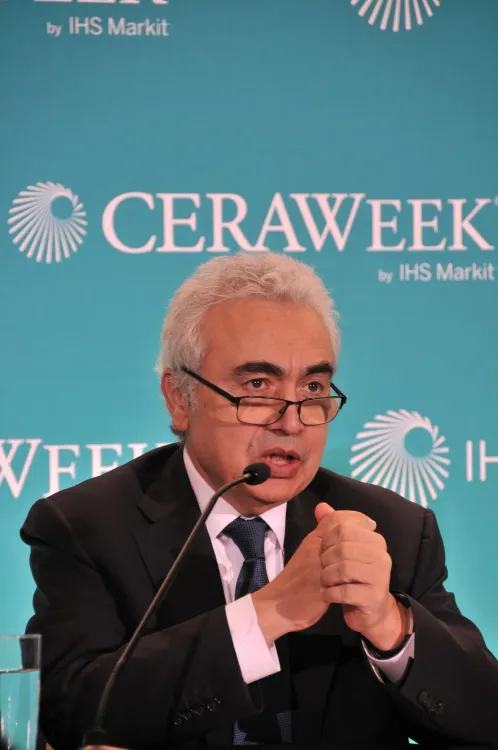Are Global Energy Diversification and Cooperation More Crucial Than Ever?

Synopsis
Key Takeaways
- Energy security threats are increasing globally, necessitating diversification.
- The IEA emphasizes the need for international cooperation in energy supply.
- Emerging economies are reshaping energy market dynamics.
- Electricity demand is outpacing overall energy consumption growth.
- Challenges in critical mineral supply chains pose additional risks.
New Delhi, Nov 12 (NationPress) Nations globally are grappling with urgent threats to energy security and escalating long-term risks across an unparalleled variety of fuels and technologies, placing energy at the center of geopolitical tensions and making it a pivotal issue of economic and national security.
In this light, the most recent edition of the IEA’s World Energy Outlook (WEO) emphasizes the necessity for governments to pursue enhanced diversification of supplies and foster greater cooperation to effectively maneuver through the uncertainties and upheavals ahead.
The 2025 edition of the WEO, regarded as the most definitive global resource for energy analysis and projections, delves into various trajectories, shedding light on distinct opportunities and vulnerabilities while also identifying common threads.
It achieves this through three primary scenarios, each outlining a unique energy future, facilitating an examination of the implications arising from different policy, investment, and technology decisions concerning energy security, affordability, and emissions.
Among the numerous trends evident across all scenarios in this year's WEO is the world's escalating demand for energy services in the coming decades, with increasing needs for mobility, heating, cooling, lighting, and additional household and industrial applications, including those related to data and AI services.
Notably, a coalition of emerging economies—led by India and Southeast Asia, along with nations from the Middle East, Africa, and Latin America—is poised to significantly influence energy market dynamics in the future.
These nations are stepping up as China, which has been responsible for half of the global oil and gas demand growth and 60% of electricity demand growth since 2010, gradually recedes in influence, although no other country or coalition is likely to replicate China's intense energy expansion.
Amid these transformations, traditional energy risks surrounding oil and gas supply security are now joined by vulnerabilities in other sectors, notably in supply chains for critical minerals where high levels of market concentration prevail.
A single nation dominates the refining of 19 out of 20 energy-related strategic minerals, holding an average market share of about 70%. These minerals are essential for power grids, batteries, and EVs, and are also critical for AI chips, jet engines, defense systems, and other vital industries.
Geographic concentration in refining has intensified for nearly all key energy minerals since 2020, especially for nickel and cobalt.
Insights from this year’s WEO regarding the announced project pipeline suggest that reversing this trend will be slow, necessitating more decisive action from governments.
“Reflecting on the energy landscape in recent decades, there has never been a time when energy security tensions have affected so many fuels and technologies simultaneously—this situation requires the same spirit and focus that led to the establishment of the IEA following the 1973 oil shock,” stated IEA Executive Director Fatih Birol.
“With energy security now a priority for many governments, their responses must also consider the synergies and trade-offs with other policy objectives—such as affordability, access, competitiveness, and climate change. The WEO's scenarios highlight key decision points ahead and collectively offer a framework for evidence-based, data-driven discussions on the future.”
Electricity is fundamental to modern economies, and its demand is growing at a pace much faster than overall energy consumption across all scenarios depicted in WEO-2025.
Investors are responding to this trend: Expenditures on electricity supply and end-use electrification currently represent half of global energy investments.
At present, electricity constitutes approximately 20% of final energy consumption worldwide, but it serves as the primary energy source for sectors that account for over 40% of the global economy and is the main energy source for most households.
“The World Energy Outlook has long highlighted the increasing significance of electricity in global economies. Last year, we declared that the world was swiftly entering the Age of Electricity—and it is evident now that it has already arrived,” Birol remarked.
“In a deviation from the past decade's trends, the surge in electricity consumption is no longer confined to emerging and developing regions. Rapid demand growth from data centers and AI is also propelling electricity usage in advanced economies.
“Global investments in data centers are projected to reach $580 billion by 2025. Those who assert that 'data is the new oil' will note that this figure exceeds the $540 billion allocated for global oil supply—a striking illustration of the evolving nature of contemporary economies.”









